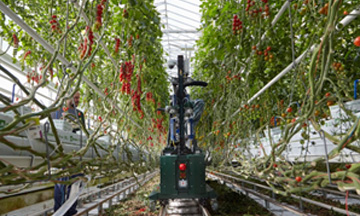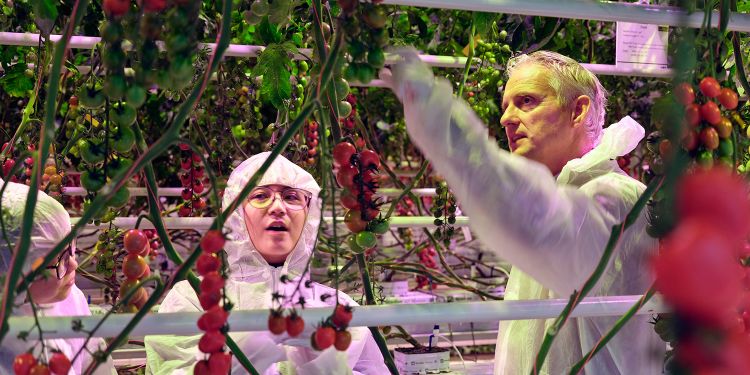In January 2024, Professors Willy Shih and Mike Toffel led 45 HBS MBA students on site visits to witness the energy transition and innovative sustainable production activities throughout Denmark and the Netherlands, in the second year of their Immersive Field Course (IFC). This is one of nine student essays that highlight their reflections.
“It’s a continuous race against the evolution of new pathogens. We as humans want to eat a lot, but so do insects, birds, viruses, etc. That’s where we come in.” - Syngenta Team, regarding developing tomatoes with resistance to the tomato brown rugose fruit virus.
Founded in 2000 from the merger of the agrichemical units of Novartis and AstraZeneca, Syngenta is a provider of a broad range of agricultural science and technology products focused on seeds and crop protection. They spend over $1.4B annually in R&D and have over 10,000 patents. We had an opportunity to visit Syngenta Tomato Vision, a 150,000 square foot greenhouse and demonstration center located in Maasland, the Netherlands. This facility opened in May 2020 and focuses on testing thousands of tomato varietal crossings every year.
The first stop on our Tomato Vision tour was Product Development & Marketing, where Product Development Specialists and Breeders explained the process for developing new tomato varieties. Many different factors (e.g., consumer preferences such as taste and shape, disease resistance, supply chain considerations, and shelf life) are considered when creating a new type of tomato with the right product-market fit. Syngenta also works closely with retailers and growers to develop new products to ensure it is not only meeting the needs of consumers, but also for the growers (for example, minimizing energy consumption during greenhouse growing, high yields) and retailers. It usually takes 8-10 years to develop a completely new tomato variety. Using modern gene mapping technologies to identify traits and accelerate the screening, crossing of existing varieties, and selection of new cultivars, shortens the development cycle to less than 5 years. However, only about 2% of all tested varieties in the greenhouse end up commercialized! Syngenta’s technology differs from genetically modified organisms (GMO) as they only leverage genes that exist naturally in tomatoes, whereas GMO introduces traits that do not necessarily exist naturally.
Fun fact: Snacking tomatoes were developed by Syngenta, and 40% of retail tomatoes sold are snacking tomatoes!

This discussion took place in the Tomato Showroom where a dozen different types of tomatoes were displayed around the room. We were fortunately able to sample different varieties of tomatoes and experience their innovative flavor profiles. For instance, we were able to try the award-winning Yoom tomato that had been created for a specific umami flavor and deep-purple color. YoomTM is one of the brands that Syngenta owns.

Our next stop was a tour of the greenhouse where Syngenta grows and is testing hundreds of new tomato varieties on any given day. We had to wear full protective coverings and go through a sanitation station in order to avoid bringing any unwanted diseases into the greenhouse. It is an active greenhouse, meaning the team has full control over the climate and light conditions. Inside, there are dozens of rows of tomato plants growing vertically on three-story high supports. After every eight plants in a row, a new variety begins and each week a new ripe cluster of tomatoes is harvested. Research teams collect data throughout this process via sensors and measurements, such as the volume of tomatoes grown per plant per week, the shelf life of harvested tomatoes, and genetic sequence to track disease resistance.
Syngenta uses automation and AI across the greenhouse. In addition to using AI for climate control, they also collect copious amounts of data (such as fruit size, number of leaves, stem size, etc.). Syngenta has a unique mutually-beneficial program with startups: startups can come to Syngenta to test out their products and Syngenta gets free services. The coolest thing we saw was a robotic harvesting machine that identified the level of ripeness of a tomato via digital screening and machine learning, then vacuumed the ripe tomatoes off the vine and into a collection basket.
Another key discussion around the greenhouse was its energy consumption. About 30% of the facility’s costs are related to energy, and the team is continuously looking for ways to become more sustainable and efficient in their energy consumption. This facility is collaborating with other neighboring sites to collectively build out local geothermal operations. Tomato Vision also works with nearby chemical producers to use and absorb their waste CO2 to stimulate plant growth.
Syngenta also avoids using chemical pesticides to enable sustainable production, especially as the EU is reducing the amount of chemicals allowed. Syngenta uses “beneficials,” or certain insects that love eating tomato pests for pest control. The company also optimizes for bumblebees to help pollinate the tomatoes, which deters growers from using pesticides in case the bumblebees are also eradicated.

Lastly, we met with the Tomato Business Unit Head and the Sustainability Lead to understand Syngenta’s sustainability strategy. The team outlined many of the challenges around feeding the world’s growing population, from water stress and land use to the extreme impacts of drought and disease from climate change. A key part of their sustainability strategy is working very closely with all stakeholders in their value chain to ensure everyone can make sustainable decisions together.

